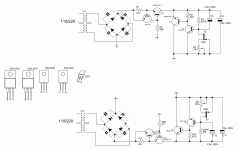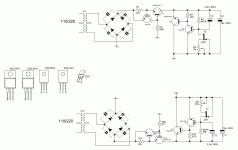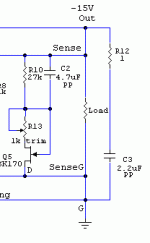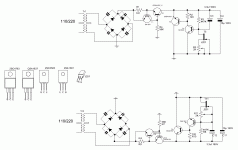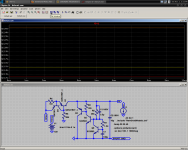Salas,
Could you not replace R4 with a zener for a fixed voltage if you wanted or would that be too noisy?
Jam
Could you not replace R4 with a zener for a fixed voltage if you wanted or would that be too noisy?
Jam
If the Zener would not need 1mF slow lytic to shut up plus would have given me the resolution of the Norton + film subjectively, why I would bother about the hard to nail rebellious Jfet kido's?😉 Slap bam Zener, off you go. Steady, no brainer. Kean chooses.
7 amp, under what conditions? Specification says Vgd=0, thus saturation in other words clipped heavily.
OK I will change it.
What VA is needed, the transformer I spec out before comes in 4.4, 10, and 24 VA...
It VA will determine the PCB layout pin placement. I guess you can say I am laying out something...
Thanks
What VA is needed, the transformer I spec out before comes in 4.4, 10, and 24 VA...
It VA will determine the PCB layout pin placement. I guess you can say I am laying out something...
Thanks
Ok
Are there any HIGH wattage resistors, and are there any special Caps that have to be used?
Thanks for bringing me up to date.
Are there any HIGH wattage resistors, and are there any special Caps that have to be used?
Thanks for bringing me up to date.
There is C3 MKP radial (Vishay's best) and C4 C-R-A-P ESR lytic 160V. I don't see more than 20mW on the 430K(?) reference for 90V target.
2PCS 3.3uF 250V VISHAY ERO MKP 1845 Polypropylene Caps - eBay (item 350336451398 end time Nov-29-10 07:36:25 PST)
This is not a radial and it 250V but this is the flavor of the beast...
Are you saying you want a HIGH Esr on the other one?
Thanks
This is not a radial and it 250V but this is the flavor of the beast...
Are you saying you want a HIGH Esr on the other one?
Thanks
Krisfr, for C4 choose the closest 160V lytic between 47-10uF, and make sure it doesn't look very cool or special. Maybe use a "long lifespan" or "high reliability" part.
As for the outputs, why not make a board where you can snap off 1/3 of the end if you only want 4 outputs rather than 6?
Why not make the PSU board adaptable between Jfet and Zener ref?
Wait, I just had... A GENIOUS MOMANT!!! Look at the schematic below. We have tempco correction, and it gets 130mV drift. Furthermore, the BJT reference acts like a very large inductor with a 1.2k parallel resistor, which boosts bass performance.
It is odd though. The Ib tempco of Q5 is introduced, and this causes a "bandgap" tempco effect. How consistent this will be in real life I don't know. You can see this in the attached simulation. The trace color follows ROYGBIV, at 20C, 30C and 40C for ROY respectively. You can see that at orange it drifts down once more after peaking at 30C.
My previous simulation can easily be modified to this version, as it already includes the device models.
- keantoken
As for the outputs, why not make a board where you can snap off 1/3 of the end if you only want 4 outputs rather than 6?
Why not make the PSU board adaptable between Jfet and Zener ref?
Wait, I just had... A GENIOUS MOMANT!!! Look at the schematic below. We have tempco correction, and it gets 130mV drift. Furthermore, the BJT reference acts like a very large inductor with a 1.2k parallel resistor, which boosts bass performance.
It is odd though. The Ib tempco of Q5 is introduced, and this causes a "bandgap" tempco effect. How consistent this will be in real life I don't know. You can see this in the attached simulation. The trace color follows ROYGBIV, at 20C, 30C and 40C for ROY respectively. You can see that at orange it drifts down once more after peaking at 30C.
My previous simulation can easily be modified to this version, as it already includes the device models.
- keantoken
Attachments
Last edited:
Salas, reading through some of your comments it seems you try to avoid BJT's for shunt. Can you elaborate? Why does everyone use MOSFETs?
- keantoken
- keantoken
Krisfr, on the negative rail the caps are flipped the wrong way.
For those who can't afford films, will a lytic suffice for C3/C12 (in Krisfr's schematic)?
- keantoken
For those who can't afford films, will a lytic suffice for C3/C12 (in Krisfr's schematic)?
- keantoken
A BJT gyrator for reference with residual anti tempco? Try that on your prototype. Interesting to see results.
BJTs-Mosfets both work to reply your question. I prefer Mosfets for my subjective reasons after I used various solutions on my stuff. Like you make a Mosfet amp here when it could be BJT sorta.
Even a cheap MKT for C3/C12 will be better than a lytic. The Ero is tops. There are many MKP/MKT in radial format cheaper to choose from also. That cap is directly influential to the final tone.
BJTs-Mosfets both work to reply your question. I prefer Mosfets for my subjective reasons after I used various solutions on my stuff. Like you make a Mosfet amp here when it could be BJT sorta.
Even a cheap MKT for C3/C12 will be better than a lytic. The Ero is tops. There are many MKP/MKT in radial format cheaper to choose from also. That cap is directly influential to the final tone.
- Home
- Amplifiers
- Solid State
- Goldmund Mods, Improvements, Stability
